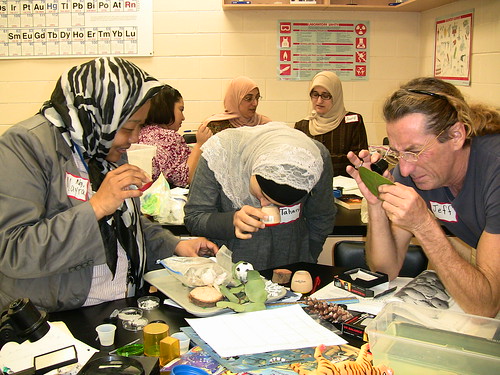As I reflect on the question of how to engage science students through technology, the issues surrounding the topic are many and varied. The group interview process opened my eyes to many other issues that stand in the way of delivering effective constructive lessons integrated with technology. There were a number of recurring themes throughout the discussions and they are all connected to my topic of study.
Interview Themes
1.Training and Professional Development
John noted, “PD needs to be timely and at the level of the learner-not just ‘one size fits all’.” Schools should not prematurely push their staff into using a particular technology or program. The time and money will be wasted. A support network, including the board and administration, needs to be in place before expecting everyone to use the technology. Local support was a topic that surfaced a number of times. If there is a teacher close by, that can guide a learning teacher, it reduces frustration and encourages more technology use. This mentor teacher relationship is even more important to new teachers who do not have the experience coming out of university.
There is a need for consistent follow-up, not just a good presentation that stirs an initial excitement. Without a follow-up and regular support, the excitement turns to frustration and then a falling away, back to original patterns. It was suggested by, ________ that a 5-minute technology PD moment/training be presented at staff meetings to introduce what is new, what is working and what might need to we changed.
A reduced workweek came up a few times, which would allow time for teachers to collaborate, practice technology use and create new lessons. The general feel was that teachers and students would appreciate the time and effort but schools boards and parents would not support it.
2. Inequity of Resources
Some schools choose to make technology a required item on their school supply list and students BYOD (Bring Your Own Device). Some of the devices may include smart phones, tablets, graphing calculators, or laptops. Of course there are issues surrounding the BYOD theory, which include, inequality among students, item repair and support, and remembering to bring the devices to class. Other schools choose to provide basic technology, signed out for in-class use. There seem to be a number of issues related to not having the technology readily available in the classroom. If it is not on-hand, it goes unused and students miss out. The cost seems to be the bottom line in this case. Can schools afford to buy the technology, have it installed, provide the appropriate training and professional development, and replace items that break, wear out, or become obsolete?
3. Direction
Educational technology has influenced our classrooms greatly, especially over the last few years with the introduction of the personal home computer and now the smart devices carried by many of our students. We cannot really predict what the best technology or computer programs will be in the next 5 years so we need to be cautious in our technology decision making. Darren mentioned that, “Maybe we need to be the anchor the holds the kids to the real, concrete world, as their digital world swirls around them.” I see no harm in this as the real world will always be there to greet them when they unplug. I believe that as we strive to find balance between concrete and virtual experiences we will find that the two can co-exist together to create a firmer understanding of concepts.
Further Questioning
There is room for further insight into the topic of engaging students like:
- How do students view technology integration in their classrooms?
- What technology do students want to use throughout their educational experience?
- What specific strategies create an engaging technological experience for teachers and students?
I do not see any easy answers to the challenge of engaging students through technology as both teachers’ and students’ backgrounds and experiences with technology vary greatly. I look forward to researching effective and proven strategies that engage learners and sharing them with the rest of the class and colleagues.
Dennis




In my mind, if one could find good resources that showed research related to BYOD, or at least to the literature the program it cites, this would be a great topic for exploration. Barring that the general question about equity in the Math and Science classroom, within schools and between schools/regions/countries, would be a hot topic too. One thing I always find strange about this type of debate is the idea that we are creating a digital divide between schools, or creating a haves and have-nots dichotomy. It always leads me to wonder if there was a time that things were ever equal anyway? There are schools in East Africa, for example, that are happy to receive a truck load of textbooks or story books, as if they were the cutting edge of educational technology. And the thing is, they might have been waiting for those books for twenty years. This “divide” is not a new thing at all, but something that existed long before digital technology started to play a part in Western schools. Closer to home, I seem to remember that classes have realistically always been a BYO arena. Some of my friends had beautiful metal protractors. Others had plastic ones with chips and dents that made it almost impossible to really draw a perfect semi-circle. I have to wonder now why one was ever up in arms about my plastic tool set?